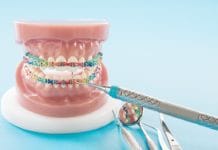A few nights ago, the boyfriend and I went out to dinner at one of our favorite restaurants. If you’re ever in the Phoenix area, make sure you enjoy a cocktail and dinner at The Gladly, as it truly is an experience. In fact, I’ll happily join you, shoot me a Facebook message!
Our favorite part about The Gladly: we have been there so many times that we are as close to a “celebrity couple” as two millennials with a flair for unique cuisine and a palate for curious cocktails can be. Of note, we have our own customized cocktails at The Gladly. His is a scotch-whiskey blend poured over a sushi-grade ice ball with a spritz of orange peel. Mine is a dirty gin martini shaken with mint and basil topped with blue cheese stuffed olives (it’s just as delicious as it sounds). I used to be the only person who ordered this cocktail, but because we bring so many people with us, it has gained popularity. The bartender now knows my customized martini by the name the waitstaff created for it, “the forest floor,” due to the green color it assumes from the herbs.
On any given night, we walk through the large glass doors of The Gladly, and the host knows we will be seated in Tim’s section, while the bartender begins curating our cocktails. There is something so incredibly glamorous about walking into an upscale restaurant, and receiving your cocktail from your favorite server, without having to open your mouth.
Meanwhile, at our local Thai place, which we have been ordering weekly takeout for the past seven years, they have NO clue who we are. We arrive to pick up our pumpkin curry with a side of spring rolls and are packed into the entryway of the restaurant like sardines, and the same woman who has been ringing us up for YEARS asks for our name and order for pickup. This restaurant is B.Y.O.B, so sometimes we will come in with a chilled bottle of Unoaked Chardonnay (the only way to enjoy Chardonnay, by the way) and are served by the same person, who seems surprised that the silver fox and ginger who can’t get off her iPhone are back AGAIN, and want wine glasses, AGAIN.
While Tim spends the better part of his evening with our table, as we enjoy the new additions to the wine list or a chef-curated dessert, the award-winning Thai restaurant up the street wants us IN and OUT in as little Thai-me as possible (see what I did there?). We love both of these restaurants equally, but the reality is: we certainly have come to expect completely different experiences from both establishments.
It is important for dental offices to recognize patients present with varying expectations of their experience. For dental practices, integrating an assisted hygiene schedule, in which patients do not receive a full hour of attention from the dental hygienist, makes it important to accept that patients may be enjoying the pumpkin curry at home instead of a forest floor martini with a complimentary dessert, if you get my drift. A dental practice must evaluate the types of patients who may not be able to align with what the hygienist can provide when performing an assisted hygiene schedule.

Let’s evaluate:
Chatty Kathy: We all know the patients within our practices who occupy additional time simply because they won’t stop talking. They are the patients who consistently present with a mouthful of stories on top of their dental needs; we struggle to get our hands safely into their flapping trap and forget about adequate instrument adaptation while Chatty Kathy yaps through her hygiene treatment. Any unsuspecting individual who enters Chatty Kathy’s operatory is guaranteed to unknowingly lock into a seemingly endless conversation about who-knows-what. The entire office staff works together to identify creative ways to save the current victim entrapped in Kathy’s conversational web and with little success, the schedule falls dramatically behind. The office struggles to catch up in the aftermath.
It is safe to say patients who consistently occupy the sound wave space within the practice are not patients who will effectively adapt to an assisted hygiene schedule. The choreographed dance of providers and staff who move about to care for our Chatty Kathy patients effectively becomes interrupted, and this can have a dramatic impact on the office’s bottom line. As providers, it is important we recognize our humanistic role in providing care to our patients, which often goes beyond the subgingival scaling we were trained to perform. This means reaching our patients in an empathetic way, connecting with our patients, and providing support for them. For our Chatty Kathys, assisted hygiene, heck, even a full-hour appointment, may not suffice.
Needy Nancy: You open the chart and are attacked by a plethora of pop-ups: “neck pillow,” “do not tip patient back too far,” “wants to be served coffee before appointment,” “prefers only green skittles,” you know the type. It’s not that they are horrible people; as many of us are empathetic in understanding many of these needs arise from a fear or phobia of the dental office. The truth, however, is that during an assisted hygiene schedule, they are just mentally EXHAUSTING.
Do any of you feel like you’re a hotel housekeeper when preparing your operatory for Needy Nancy? In between turn-down service and replenishing the towel supply, you somehow have to find time to actually treat your patient. By the time Nancy stops talking long enough to inhale her nitrous oxide, make sure her earbuds are fitting just right, and you’ve tucked her in with the office blanket, you’re already two patients behind, and there is just no saving yourself. Forget about keeping yourself on track: no potty breaks for you, forget about that new promise to drink more water, and I hope your patients love the whale-mating call of your hungry tummy that misses its mid-morning snack. We’ve all been there – who really wants to set themselves up for days like this on a consistent basis? It is important to recognize the Needy Nancy patients in your practice and evaluate if this is truly a patient who will conform to the confines of an assisted hygiene schedule.
Grandpa George: Who doesn’t love it when Grandpa George is on the schedule? He’s the absolutely perfect senior man who shows up early to enjoy the cartoon section of the daily newspaper, he has the best jokes, and he always has seventeen million fantastic stories about his years in the service, his grandkids, his wife, or his current hobby. He’s everyone’s favorite patient because he truly is part of the family of the practice. We are curious about how he is doing, we want to see the pictures of his granddaughter’s wedding, and we want to be in his presence. We smile behind our mask as a parade of office employees stop by, requiring us to discontinue our instrumentation so they can squeeze in a hug and “how are ya?” from Grandpa George. He makes us smile, he makes us laugh, and he reminds us of why we love what we do.
You know what’s even better? When Grandpa George brings in Grandma Georgina, and they have an adorable couples’ dental cleaning. How heart-warming is it to witness Grandpa G fawn all over Grandma G while re-enacting their own, little version of The Notebook? (Are you awkwardly grinning while reading this? THAT is how you know you’re a true hygienist!)
Is Grandpa George the best?! Absolutely! Do you LOVE Grandma Georgina? Of course! Do you wish you could have Thanksgiving dinner at their house, call them when you need some advice, and spend Sunday mornings on their tire swing out back? Without a doubt! But do they slow down your assisted hygiene schedule? Yes. More importantly, do you feel a weird sense of guilt when you see them walking hand in hand out of the office, waving to everyone as they do the cute foot shuffle out the door? Of course. As an empathetic provider, it is imperative that, at the end of the day, you feel good about the work you did for your patients, whether that means clinically or humanistically.
Argumentative Annie: “You took X-rays on me last time, I don’t need them again.” “I just want my free cleaning, not that periodontal cleaning you did on me last time.” “You’re not Susan, where is Susan?” “I don’t want you to use that water thing on me.” “My insurance won’t pay for it, so I don’t need it.” (Got goosebumps?)
We have all experienced patients like Argumentative Annie: the patients who make it a personal mission to argue with every clinical recommendation you make, belittle your clinical knowledge, and single-handedly make you question why you even went into hygiene in the first place. They are the experts on their insurance plan and are confident that Carrie, the insurance company rep, has a stronger knowledge of their dental needs than the hygienist with degrees and certifications who just spent the better part of 40 minutes in her mouth. She has an argument for everything, and despite what she thinks, her low Dental IQ makes you wish you had the time to properly sit knee-to-knee with her and educate her based on your knowledge.
But alas, you simply do not have the time, as assisted hygiene schedules rarely permit extensive time for patient education with the dental hygienist. Patients like Argumentative Annie either do well with an assisted hygiene schedule, by getting exactly what they want from their dental provider (which may not be the same as the dental care that they NEED), or they become the nightmare patient who drains the practice and cannot tolerate the lack of attentiveness within an assisted hygiene schedule.
Hot-Mess Helen: Hot-mess Helen is truly the patient who breaks my heart. Hot-Mess Helen is the reliable patient who presents every six months for her hygiene visit. She never complains, never makes a fuss, does exactly what she is told, always pre-books her next hygiene visit, and is courteous to everyone in the office. Hot-Mess Helen TRUSTS the office, despite the large radiographic triangles of calculus which show up on her FMX taken today (the first set of radiographs she has had in many years), and the bleeding 5+mm pockets with advanced recession, which were charted as a full-mouth of “3-2-3” on every tooth. Hot-Mess Helen is the patient who has been undiagnosed and mismanaged for years and countless hygiene appointments, while she implicitly trusted the providers who quite simply lacked the time to perform quality assessments and execute the gold standard of care.
While I have worked many assisted-hygiene schedules, I must admit in many cases, performing comprehensive periodontal charting, effective supra and subgingival scaling, and a few minutes for patient education, simply do not fit well in a “patient-every-half-hour” model; unless you are seeing healthy patients on a three-month recare system. In most assisted hygiene offices, where patients present every six months, and present with varying degrees of gingivitis or periodontitis, I have found that, like my favorite Thai restaurant, quality suffers in one or more areas as a result. Quality can suffer in many forms; from patient service indicated by timeliness, courtesy and concierge services, to patient care noted by incomplete treatment, subpar care or undiagnosed disease, and negligence.
Despite the love affair I have with an assisted hygiene schedule, I must admit that all too often, practices are delighted with overworking their providers with schedules of dozens of low-productive patients, who are getting the best care possible, with less than thirty minutes of undivided attention. These patients spend the better part of thirty minutes getting their hygienists’ “best” attempt at a bloody prophy, while their body releases C-reactive proteins, neutrophils, and cytokines in response to the unmentioned, inflammatory process their mouth is constantly releasing.
These patients leave after their recare appointment every six months with varying degrees of an undiagnosed, low-grade infection we know will enter the bloodstream to exacerbate chronic diseases such as diabetes, heart disease, and cancers, to name a few. These patients walk out with active decay, little understanding of how their diet plays a role in their oral disease, and no tangible solutions for remineralization. These patients are walking around with suspicious oral lesions, unmentioned risk factors for oral cancer, and no support for tobacco cessation.
It’s no wonder we are burnt out!
We receive our degrees in an incredibly intensive and comprehensive industry which considers us to be respected providers, we seek continuing education coursework in unique areas of our industry that fascinate us, and we truly take pride in the good work we are called and compelled to do. When we are placed in a 30-minute cage with our knowledge wings clipped, we become stagnant, stifled, and resentful.
To be clear: I do believe there is a time and a place for assisted hygiene, as long as it is done correctly. Please stay tuned for Part 3 of my Assisted Hygiene series on perhaps the most important aspect of an assisted hygiene schedule: The Assistant. Cheers!
To catch up on Assisted Hygiene Part 1: Is Your Office Prepared click here!













